-
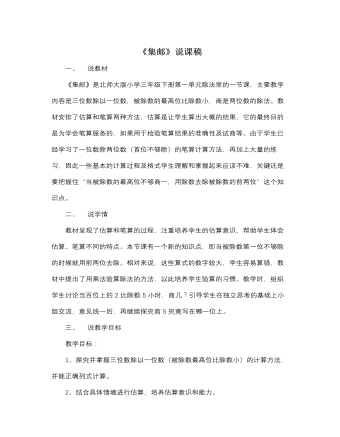
北师大版小学数学三年级下册《集邮》说课稿
《集邮》是北师大版小学三年级下册第一单元除法里的一节课,主要教学内容是三位数除以一位数,被除数的最高位比除数小,商是两位数的除法。教材安排了估算和笔算两种方法,估算是让学生算出大概的结果,它的最终目的是为学会笔算服务的,如果用于检验笔算结果的准确性及试商等。由于学生已经学习了一位数除两位数(首位不够除)的笔算计算方法,再加上大量的练习,因此一些基本的计算过程及格式学生理解和掌握起来应该不难,关键还是要把握住“当被除数的最高位不够商一,用除数去除被除数的前两位”这个知识点。二、说学情教材呈现了估算和笔算的过程,注重培养学生的估算意识,帮助学生体会估算、笔算不同的特点。本节课有一个新的知识点,即当被除数第一位不够除的时候就用前两位去除。相对来说,这些算式的数字较大,学生容易算错,教材中提出了用乘法验算除法的方法,以此培养学生验算的习惯。
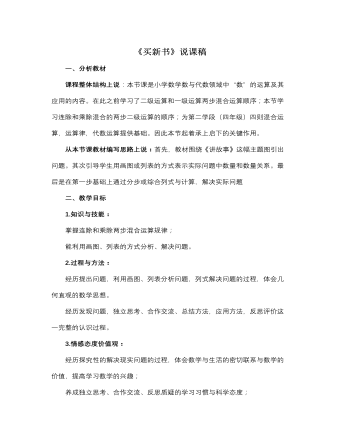
北师大版小学数学三年级下册《买新书》说课稿
2.应用意识方面,解决问题能力较差。一方面是符号意识、应用意识需要发展,从现实问题抽象出数学问题的能力和主动用数学思想分析现实问题的习惯。二是分析问题、解决问题的策略缺乏、灵活使用的能力不足(几何直观、模型思想、归纳、类比、逆向思考等方法)。五、教法、学法教法:利用谈话法,引导学生思考、探究的过程,实现教师主导下的学生的自主建构。利用讲解法,在探究学习的基础上,教师和学生共同对重点、难点进行梳理,引导学生建立清晰、系统的知识结构。利用练习法,巩固知识,发展学生的运算能力、符合意识、应用意识。学法:自主探究,有利于形成主动思考的习惯,思维能力获得提高。成功的探索使其获得理智感,有益于学习兴趣的培养。合作学习,交流比较,质疑反思的经验有利于学生创新能力的提升。合作交流同时也促进个性、社会性的发展。
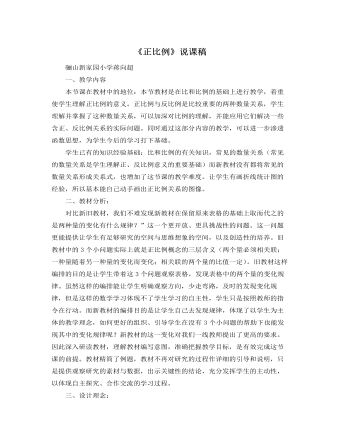
北师大版小学数学六年级下册《正比例》说课稿
{二}、努力实现扶与放的和谐统一,共同构建有效课堂。学生能自己解决的决不包办代替:学生可能完成的,充分相信学生,发挥自主探索与合作交流的优点,让学生有一个充分体验成功展示自我的舞台;学生有困难的,给予适当引导,拒绝无效探究,提高课堂效率。四、教学目标:基于对教材的理解和分析,我将该节课的教学目标定位为:1、帮助学生理解正比例的意义。用字母表示变量之间的关系,加深对正比例的认识。2、通过观察、比较、判断、归纳等方法,培养学生用事物相互联系和发展变化的观点来分析问题,使学生能够根据正比例的意义判断两种量是不是成正比例。3、学生在自主探索,合作交流中获得积极的数学情感体验,得到必要的数学思维训练。
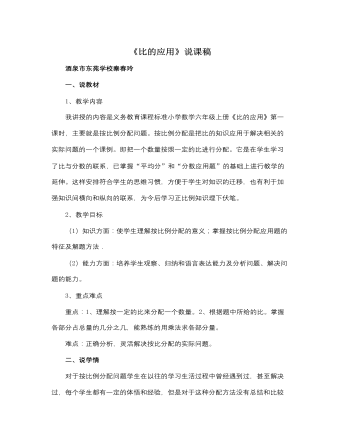
北师大版小学数学六年级上册《比的应用》说课稿
接下来引导学生分析题中数量关系:题目要分配什么?按照什么分配?重点思考讨论:从3:2这个比中,你能知道什么?接下来鼓励小组合作尝试多种方法解答,重点理解按比分配的方法。2、小结:按比分配的应用题有什么结构特点?怎样解答这样的应用题?这样设计为学生提供自主探索的空间。所以在教学中可以灵活地依据提出的方法调换教学顺序,并引导学生掌握两种不同的解题方法。安排学生的小组讨论方式能使学生一开始就畅所欲言,把几种不同思路比较和联系起来,在理解的基础上才能更好的掌握方法,并注意培养学生的检验能力。第三个环节:多层训练,形成技能。练习是数学课堂教学一个重要环节,我设计的练习题力求做到从易到难,由浅入深,有层次,有坡度,新旧知识融合恰当,形成技能技巧,开拓思维,发展能力,达到练习的预期目的。
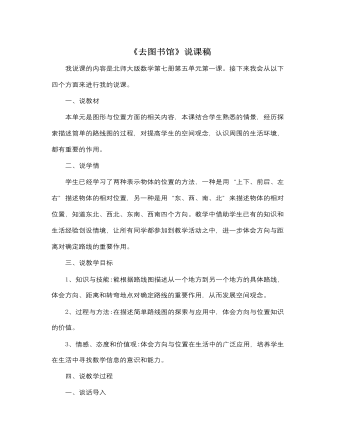
北师大版小学数学四年级上册《去图书馆》说课稿
一、说教材本单元是图形与位置方面的相关内容,本课结合学生熟悉的情景,经历探索描述简单的路线图的过程,对提高学生的空间观念,认识周围的生活环境,都有重要的作用。二、说学情学生已经学习了两种表示物体的位置的方法,一种是用“上下、前后、左右”描述物体的相对位置,另一种是用“东、西、南、北”来描述物体的相对位置,知道东北、西北、东南、西南四个方向。教学中借助学生已有的知识和生活经验创设情境,让所有同学都参加到教学活动之中,进一步体会方向与距离对确定路线的重要作用。三、说教学目标1、知识与技能:能根据路线图描述从一个地方到另一个地方的具体路线,体会方向、距离和转弯地点对确定路线的重要作用,从而发展空间观念。2、过程与方法:在描述简单路线图的探索与应用中,体会方向与位置知识的价值。3、情感、态度和价值观:体会方向与位置在生活中的广泛应用,培养学生在生活中寻找数学信息的意识和能力。
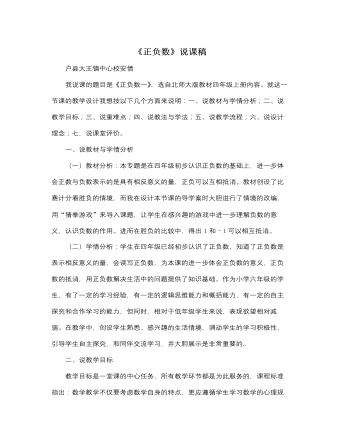
北师大版小学数学四年级上册《正负数》说课稿
二、说教学目标教学目标是一堂课的中心任务,所有教学环节都是为此服务的,课程标准指出:数学教学不仅要考虑数学自身的特点,更应遵循学生学习数学的心理规律??使学生获得对数学理解的同时,在思维能力、情感态度与价值观等方面都得到进步和发展。根据这一要求和本节教学内容,并结合学生的实际情况,本节课我确定如下学习目标:1、知识与技能在熟悉的生活情景中,进一步体会负数的意义;会用负数表示一些日常生活中的问题,知道正负可以相互抵消。2、过程与方法本节课以小组合作学习为主,让学生利用导学案自学,再对学、群学,最后在班里进行展示。整节课都是学生自主学习,积极探索的一个过程。3、情感、态度与价值观经历独学、交流、合作、展示等一系列活动,通过生生、师生互动获得良好的情感体验,同时让学生感受到了数学在生活中的应用。依据这样的教学目标,再结合学生的年龄特点,我运用了浅显易懂的儿童语言制定了导学案上的学习目标。
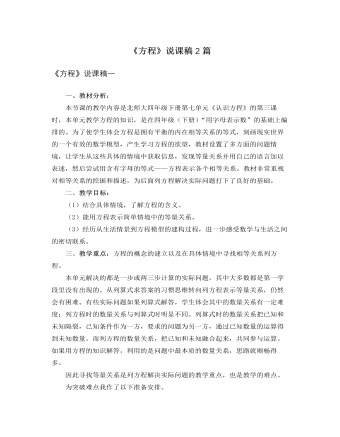
北师大版小学数学四年级下册《方程》说课稿2篇
3、变换角度,深入思考第三幅情境图隐含着多样的等量关系,也正是引发学生数学思考的最佳情境。根据学生认识的深入程度,可适当让学生体会到等式的“值等”和“意等”,并放手让学生探究,根据不同的认识找到不同的等量关系,列出等量关系不同的同解方程。在教学中,先引导孩子发现情境中的基本相等关系:2瓶水的水量+一杯水的水量=一壶水的水量,并且列出等式2z+200=2000,在此基础上,再引导孩子发现其他的等量关系。在这一过程中,充分激发孩子探求知识的欲望,调动孩子思考的主动性和灵活性,从而找到多样化的等量关系,并进一步提高孩子解决数学问题的能力。4、建立概念,判断巩固在前面教学的基础上总结、抽象出方程的含义。通过三道例题的简洁数学式子表达,让小组合作寻找他们的共同特点,从而建立方程的概念。“含有未知数”与“等式”是方程概念的两点最重要的内涵。并通过“练一练”让学生直接找出方程。
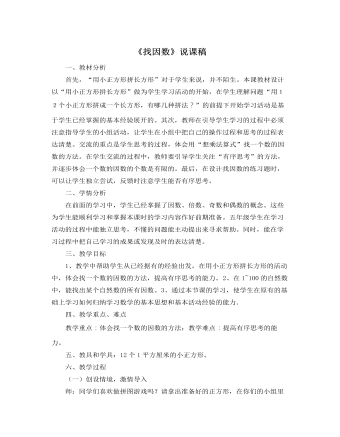
北师大版小学数学五年级上册《找因数》说课稿
【设计意图:让学生在操作、探索的基础上,组内交流想法,再在班内交流汇报,让学生的语言得到相互交流、碰撞,从而不断激发学生的思维火花。】师:你能把这些摆法用算式写出来吗?(学生独立写出算式并汇报)依学生汇报板书:1×12=122×6=1212×1=126×2=123×4=124×3=12师:请同学们观察一下,哪两道算式的因数一样?学生观察算式,找出因数一样的算式。师:那么,这6个算式最少能用几种算式表示出来?引导学生说出能用3种方法表示,这三种方法是:1×12=122×6=123×4=12,并指明算式一样时选择其中一种说出来。板书:12=1×12=2×6=3×4师:同学们观察一下,12的因数有哪几个?(学生说出12的因数有:1、12、2、6、3、4。)师:拼长方形与找因数有什么关系呢?(指名学生说一说)师:根据刚才的操作交流,请同学们说一说怎样找一个数的因数呢?(学生思考片刻后汇报,可以组内交流。)引导学生说出:用乘法思路想,看哪两个数相乘得12,然后一对一对找出来。
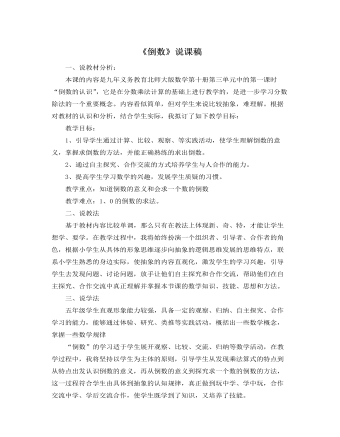
北师大版小学数学五年级下册《倒数》说课稿
教学目标:1、引导学生通过计算、比较、观察、等实践活动,使学生理解倒数的意义,掌握求倒数的方法,并能正确熟练的求出倒数。2、通过自主探究、合作交流的方式培养学生与人合作的能力。3、提高学生学习数学的兴趣,发展学生质疑的习惯。教学重点:知道倒数的意义和会求一个数的倒数教学难点:1、0的倒数的求法。二、说教法基于教材内容比较单调,那么只有在教法上体现新、奇、特,才能让学生想学、要学。在教学过程中,我将始终扮演一个组织者、引导者、合作者的角色,根据小学生从具体的形象思维逐步向抽象的逻辑思维发展的思维特点,联系小学生熟悉的身边实际,使抽象的内容直观化,激发学生的学习兴趣,引导学生去发现问题、讨论问题,放手让他们自主探究和合作交流,帮助他们在自主探究、合作交流中真正理解并掌握本节课的数学知识、技能、思想和方法。
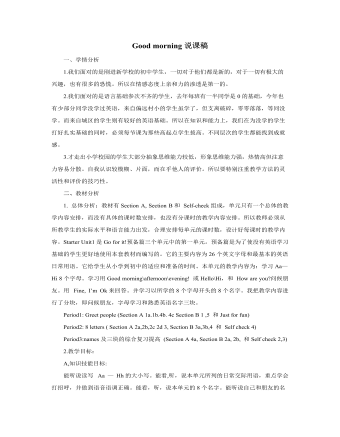
人教版新目标初中英语七年级上册Good morning说课稿
1.课堂活动中的竞赛制:以记奖评优的形式无声的评价每一个活动,包括个体和小群体。在第一课时评最佳演员和导演奖,第二课时评最佳团体奖,既节约时间又明确有效。使学生能提高语言质量,增强参与意识,提高学习兴趣。2. 教师课堂上语言、表情激励制:在课堂活动中教师要乐于 、善于用激励性语言。从good, super, smart, excellent , great ,wonderful等,用微笑,皱眉,摇头、点头等身体语言对于学生的评价是方便又有效的途径。3.课后作业评价:口头作业在第二天课堂上表演,接受全体同学的评价。笔头作业有教师批阅,以评语的方式出现。优秀作业予以展出或交流。积极地肯定和鼓励学生是我们评价的重要目的之一。4.单元结束后综合性评价:除了笔试以外,也可以根据学生实际开展丰富的活动,如:调查报告、小品表演、专题演讲等。

人教版高中英语必修4Body Language说课稿4篇
Textbook: Senior English for China (Book 4), by Liu Daoyi Time Allotment: 1 period (40 minutes)Date: March 20, 2014Teaching aids: blackboard, Multi-media, Power Point, chalk I. Text Analysis (教材分析)This unit is about body language, and the text selected in the reading part demonstrates the difference and similarity of body language in many parts of the world. Through learning this passage, students are required to raise their awareness of using body language in different parts of the world. As body language is closely related to our daily life, it is easy to arouse students’ interest in learning this text. Reading skills and speaking training are designed around the text.II. Teaching Objectives (教学目标)By the end of the lesson, students will be able to:1. Language Skill Objective(语言技能目标): develop reading ability (skimming and scanning)as well as speaking ability.2. Cultural Knowledge Objective(文化知识目标): know about the cultural differences of using body language.3. Affective Objective(情感目标): increase students’ awareness of using body language correctly in different cultures. III.Teaching Focuses and Difficulties(教学重点和难点)1. Teaching Focuses(教学重点): the difference and similarity of body language in many parts of the world.2. Teaching Difficulties(教学难点): develop students’ reading abilities of skimming and scanning and ask the students to show their opinions with fluent English.

人教版高中英语必修1Nelson Mandela--A Modern Hero说课稿
In this step, give students a few minutes to read the passage . While they are reading, I will write some key words of the text on the blackboard. Then ask students to retell the passage according to the key words.By retelling, students can improve their ability of language organization and have an overall understanding of the article.Step 4 Group discussionIn this step, students will be divided into groups of 4 to discussion the following question: What qualities make a great person?After their discussion, invite a few groups to make a report to the class.This group discussion can practice students’ oral English and cultivate their abilities of cooperation and communication.Step 5. HomeworkLet students write a short passage to introduce a great person he or she admires.The homework can consolidate the knowledge the students have learned and cultivate their writing ability. Part 6 Blackboard Design(板书设计)That’s all my teaching procedures. Finally, I’d like to say sth about part 6 blackboard design. On the top is the title. On the left, there will be some new words and expressions. In the middle of the blackboard, I will write some useful sentence structures so that the students can know clearly what they’ve learned and then try to master the knowledge.OK. That’s all for my presentation. Thank you for your attention.

人教版高中英语必修3Astronomy the science of the stars说课稿3篇
Step 2 Pre-listeningAfter students finish their discussion, I will show a picture of Newton and ask them: Who is him? What is he famous for? Could you find out some words to describe him? Maybe students will answer that he is genius for his finding of theGravitation, making a great contribution to the progress of human being. At that time I will show another two pictures of Einstein and Hawking, letting students guess who they are and write down their idea about the Gravitation. For I have arranged them to search more information about the gravity before this class, Students have beenfamiliar with the topic and will not be afraid about this abstract conception, which is helpful for their listening.Step 3 While-listeningIn this step, students will be required to listen the material for three times. The first and listening is extensive listening and the second and third listening is intensive listening. In the first time, They are required to listen a material including Part 1 and Part 2 and choose the best summary of the listening text. After they choose the right answer, They also need work in group to explain what is wrong with the others. Then I will make a conclusion that we should pay attention to the first paragraph and last paragraph and some keys to get the main idea. By doing this, their capacity of generalization will have a great improvement.Before the second listening, I will ask students to scan the blank on the power point quickly and ask them to note down some key words .Then ask them to listen to the Part 1again and fill the first column of the chart. Maybe some students just show the ideas of these three scientists an still can’t catch their development of gravity. Therefore, I will ask them to listen to Part 2 again and fill in the rest. After finish the listening, I will give them ten minutes to discuss with their partner. I will also guidethem to improve their answers when they discuss with others.

人教版高中英语必修3Canada-the true north说课稿4篇
Good afternoon, teachers, It’s my great pleasure to be here sharing my lesson with you.The content of my lesson is Senior English Book 3 Unit 5 Canada —— “The true North”.I’ll be ready to begin this lesson from five parts. Analysis of the teaching material,the teaching methods,the studying methods, the teaching procedure,and Blackboard design.First, let me talk about the teaching material.Part 1 Teaching Material:This unit is about the introduction of Canada. By studying of this unit,we’ll enable the students to learn the geography, population, main cities, and natural beauty, natural resources of Canada. Through the training of the unit, it also requires students to learn some Language skills such as the expressions of position and emotions.So it plays an important part in the English teaching in this book.After studying the teaching material and analyzing the rule of children’s growing of mind,I think the teaching aims are the followings:1.Knowledge objects:(1) make the students learn some new words and phrases(2) make the students understand the content of the lesson.2.Ability objects:(1)To develop the Ss’ abilities of listening, speaking, reading and writing. Especially reading and speaking ability.(2) learn to talk about the characters of Canada in English(3)To train the Ss’ ability of working in pairs.3.Emotion objects:(1)Enable students to understand the characters of Canada..(2)Stimulate Ss to work hard to make China stronger.Part 2 Teaching Methods:I think helping students learn to master new words and phrases and improve the students’ reading and speaking ability is import and the difficult.According to the analysis of the teaching material and the import points and the difficult points,I will use the following teaching methods : question-guiding approach; fast-reading and careful reading; multi-media teaching methods; discussion

人教版高中英语必修4Theme parks说课稿3篇
The oldest and the most popular park in the worldenjoy the exciting activities thereget close to the life-size cartoon characters like Mickey Mouse and Donald Duck Step 3 Pre-reading1.What do you suppose a theme park is ?2.What do you think you can see in a theme park?(1.It is a kind of amusement park which has a certain theme – that the whole park is based on. 2.buildings, castles, statues, rare animals and birds, and so on.) Step 4 Reading ----- Theme Parks –---- Fun and More Than Fun1.Predict : Read the title and the pictures on P. 34 and PredictWhat is the meaning of the title “Theme Park – Fun and more than fun”?(The title means that theme parks are fun to visit, but that they can also be educational and can offer useful information.)2.Skimming Fast read and answer:What activities can we take in a theme park?Amusement park: Bumper car Merry-go-round slide bungee jumping Free-fall rides Horror films Pirate ship Ferris wheel roller coaster3.Scanning Read again and you will find various theme parks are mentioned in the passage . Then what are they ?Theme parks: Sports theme park History theme park Culture theme park Marine or Ocean theme Park Future park Science theme park Disneyland4.Careful reading and find the main idea of each paragraph:THEME PARKS---- entertaining/ educationalPara.1 Traditional parks are places to go for relaxation and to have time away from our busy lives.Para.2 Theme parks are different They’re large and full of things to do, see and buy.Para.3 Theme parks are built around a single idea or theme. One example is a sports park.Para.4 Another kind of theme park is historical more and cultural and can be educational.Para.5 Disneylandwas the first theme park. It is based on the fantasy life and characters of Disney’s films.Para.6 Some examples of educational theme parks include sea world parks and science parks.

人教版高中英语必修3The million pound bank note说课稿3篇
在接下来的细读环节,我套用了高考对阅读理解的考查方式设置了5个问题,分别为三个推理判断题,一个细节题和一个主旨大意题。学生需要对文章的内容进行分析、归纳、推理、猜测等高级思维活动才能做出正确的回答。【设计意图】这一过程是对学生进行细读的训练,培养学生获取特定信息和挖掘文章深层次信息的能力。第三环节:Intensive-reading (精读) 15′第三个环节精读,既是最重要的环节,也是突破本课重难点的关键。首先,让学生思考剧本中人物看到百万英镑前后的态度发生了怎样的变化。其次,让学生仔细阅读文章,找出可以表现人物态度变化的具体的语言和动作。最后,让学生总结人物的态度发生变化的根本原因是什么,从而引出Money Talks, 供学生思考。【设计意图】通过一系列的活动培养学生学习从人物的语言和动作探究人物的心理,使学生进一步体会戏剧语言的魅力,从而对文章背后所反映的社会问题进行思考,也为下一步的讨论环节做好铺垫。

人教版高中英语必修5Life in the Future说课稿5篇
Good afternoon, everyone. It’s my great pleasure to be here sharing my lesson with you. The content of my lesson is Senior English for China Book5 Unit 3 Life in the Future. I’ll be ready to begin this lesson from six parts: Analysis of the teaching material, Analysis of the students, Teaching aims and important and difficult points, Teaching methods and aids, Teaching procedures, and Blackboard design. First, let me talk about the teaching material.Part 1 Analysis of the Teaching Material:This unit is about what human beings’ life will be like in about one thousand years. By studying of this unit, we’ll Enable the students to know the changes in humans’ life and some new inventions bringing about the change and develop the interest in science. This lesson plays an important part in the English teaching in this unit. This is an important lesson in Book Five. From this lesson, it starts asking the Ss to grasp contents of each passage. Therefore, this lesson is in the important position of the teaching material. If the Ss can learn it well, it will be helpful to make the Ss learn the rest of this unit.Part 2 Analysis of the SsAs Senior2 Ss, they are at different levels of English fluency, some of them have lost interest in English. So during the lesson, I arrange a variety of activities to let all of them join in to attract their interest and let them be confident and taste the joy of success.
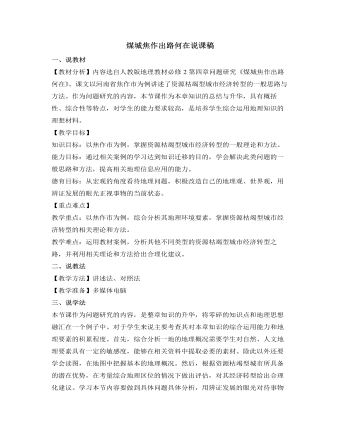
人教版高中地理必修2煤城焦作出路何在说课稿
分析过焦作市的地理概况和产业优势后,就需要针对由于资源枯竭所带来的问题提出合理化的建议。既然是谈经济转型,就应该将话题的范围明确在这一领域内。通过材料3的相关内容,我们了解到焦作市需要在产业结构调整、培育新的优势产业、增强综合竞争力等三个整改方针上下功夫。因而引导学生针对优势与不足提出建议,以三个整改方针为基准,衡量建议的可行性是锻炼学生解决此类问题的有效途径。在此我将教会学生的是解决问题方法而非案例的内容,正所谓“授之以鱼,不如授之以渔”。接下来针对学生的建议和教材资料分析所罗列的10点整改思路,由学生自由发言提出看法,通过教师的指导和学生的讨论,进而确定经济转型建议的具体方案。最后注意将建议与产业优势相对照,看建议是否都是围绕着产业优势而提出的,这样做会加深学生的印象,通过建议和优势的对应关系,将不难找出此类问题的解题思路。
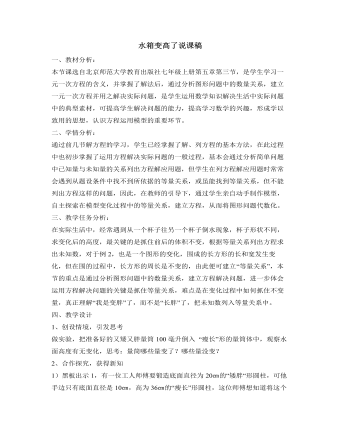
北师大初中数学七年级上册水箱变高了说课稿
一、教材分析:本节课选自北京师范大学教育出版社七年级上册第五章第三节,是学生学习一元一次方程的含义,并掌握了解法后,通过分析图形问题中的数量关系,建立一元一次方程并用之解决实际问题,是学生运用数学知识解决生活中实际问题中的典型素材,可提高学生解决问题的能力,提高学习数学的兴趣,形成学以致用的思想,认识方程运用模型的重要环节。二、学情分析:通过前几节解方程的学习,学生已经掌握了解、列方程的基本方法,在此过程中也初步掌握了运用方程解决实际问题的一般过程,基本会通过分析简单问题中已知量与未知量的关系列出方程解应用题,但学生在列方程解应用题时常常会遇到从题设条件中找不到所依据的等量关系,或虽能找到等量关系,但不能列出方程这样的问题,因此,在教师的引导下,通过学生亲自动手制作模型,自主探索在模型变化过程中的等量关系,建立方程,从而将图形问题代数化。
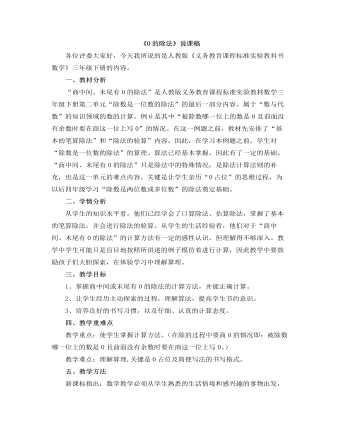
小学数学人教版三年级下册《0的除法》说课稿
一、教材分析“商中间、末尾有0的除法”是人教版义务教育课程标准实验教材数学三年级下册第二单元“除数是一位数的除法”的最后一部分内容。属于“数与代数”的知识领域的数的计算。例6是其中“被除数哪一位上的数是0且前面没有余数时要在商这一位上写0”的情况。在这一例题之前,教材先安排了“基本的笔算除法”和“除法的验算”内容。因此,在学习本例题之前,学生对“除数是一位数的除法”的算理、算法已经基本掌握,因此有了一定的基础。“商中间、末尾有0的除法”只是除法中的特殊情况,是除法计算法则的补充,也是这一单元的难点内容。关键是让学生亲历“0占位”的思维过程,为以后四年级学习“除数是两位数或多位数”的除法奠定基础。

